Adventures from Alaska to Chile

Galápagos Godzilla
2 Page Photo Spread
Floreanna & San Cristobal, Ecuador
Tour Tikal the MAYAN EMPIRE

El Petén, Guatemala
Castillo Rojo BOUTIQUE HOTEL
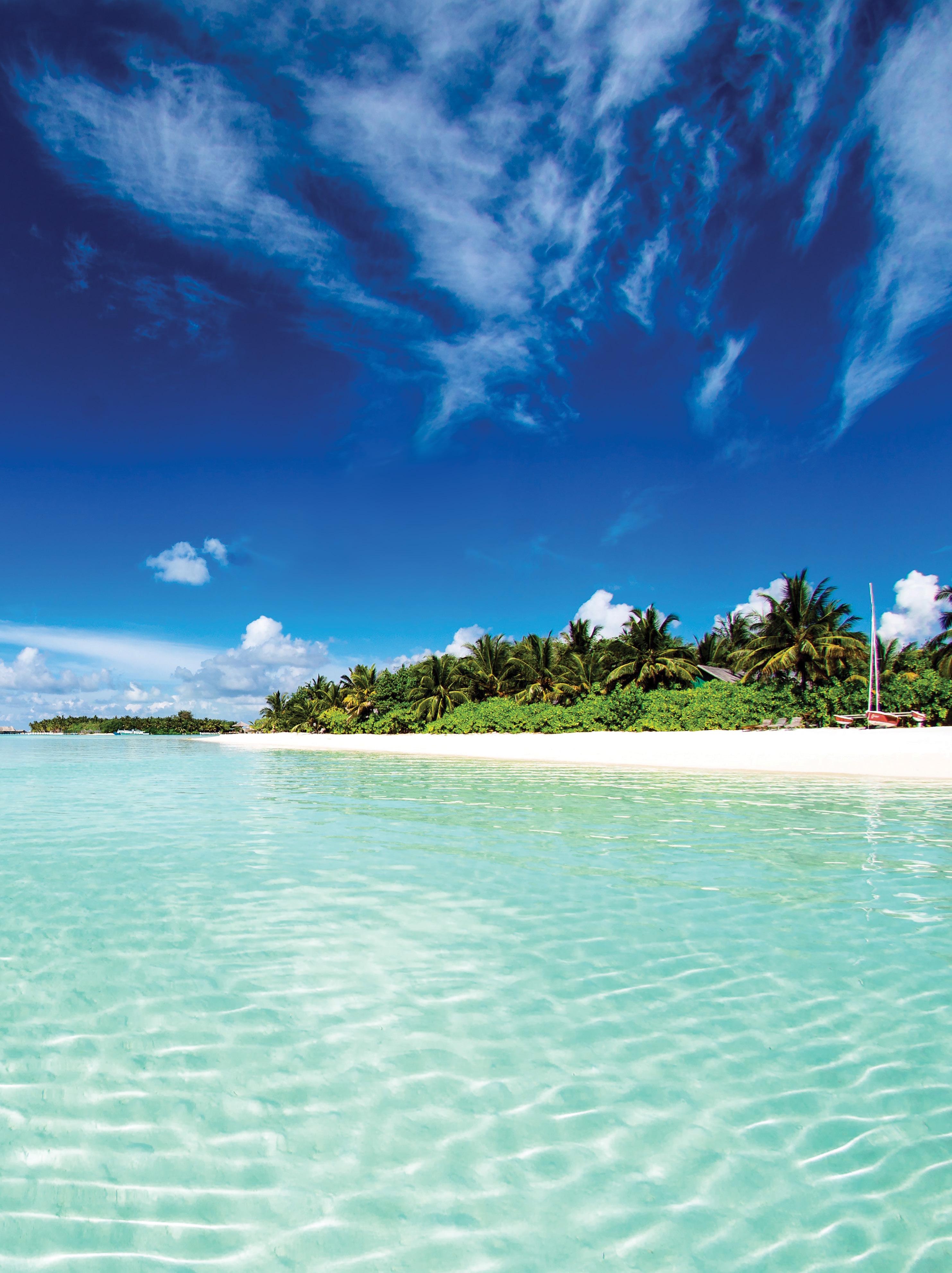
Santiago, Chile
Grizzly Bears KNIGHTS INLET
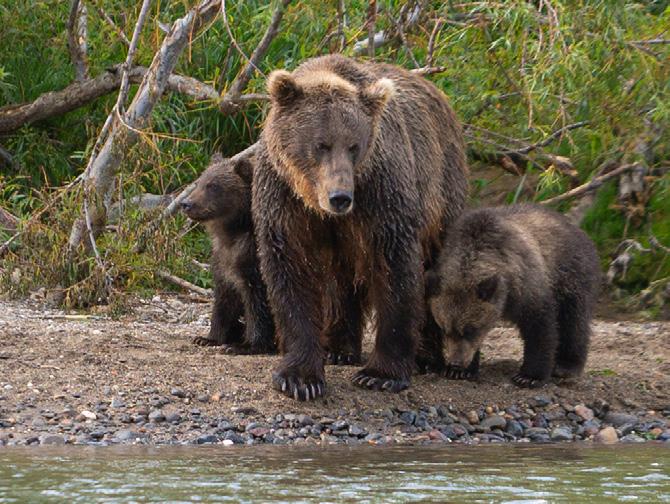
British Columbia, Canada
... and more!

December - February 2022
CANADA page 17 GUATEMALA page 5 Introductory Subscrip tion OFFER INSIDE!








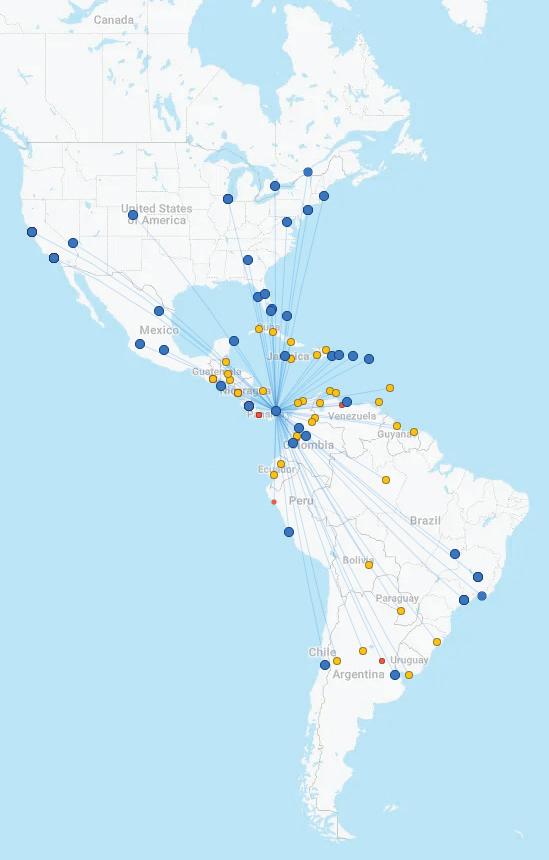


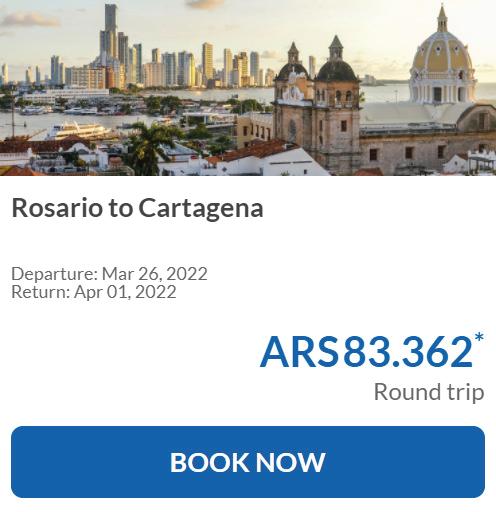

When you travel with Copa Airlines, you’ll get to your des�na�on swi�ly, safely, and conveniently, and you can rest assured that you ’ re flying with a World-Class airline commi�ed to con�nual growth. PROUD MEMBER OF Now Serving 75 I 33 Countries Economy Class Business Class 1-888-COPA AIR (1-888-267-2247) www.copaair.com Special Deals to North & South Americas Start your trip with us!
Editor’s Journal

our 1st issue
Hello fellow travel bugs!
We are enthralled to have you along on the journeys of our new and exciting Pacific Safaris Travel magazine. Let’s travel together to unique locations and events from northern Alaska to the south of Chile.
When you join us to explore intriguing destinations and exotic accommodations you will find amazing opportunities you never knew existed. We’ll bring you closer to awesome explorations retold by our adventurous freelance writers and photographers. And each issue will showcase one of the many wonderful fascinations of interest on these continents.
One in point is the incredible 5,000 km migration of the Monarch Butterfly every season to a specific mountainous biosphere of only 140, 000 acres in southern Mexico. This delicate flutterer is the farthest traveling insect and proudly represents our magazine. These butterflies are also primary pollinators and tragically, like bees, the Monarch population is rapidly declining due to insecticide use along their migration route. Pacific Safaris Travel encourages responsible change and donates 5% of all subscription fees, both on-line and print publications, to butterfly habitat restoration.

~ Our journeys together make a global difference ~
New horizons open for Pacific Safaris Travel with our introductory issue, December to February 2022. Take a moment to relax and enjoy your trips to Canada, Guatemala, Ecuador, and Chile. In this issue, we’ll view mighty Grizzly Bears, then explore the infamous Tikal ruins. We’ll soak up exotic images of the Galápagos and find comfort in a quaint historic hotel in downtown Santiago, Chile. Be sure to track the locations of these and more upcoming articles on the inside of our back cover.
Four times a year, we’ll escape on vacation together. So don’t wait! There’s an introductory offer for a 10% discount on a year subscription! This offer is only available until the next issue (March to May), proudly hits the stands on February 28.
On behalf of our travel experts, photographers, and magazine production staff, I’m happy to welcome you along with Pacific Safaris Travel throughout these beautiful North and South Americas.

All aboard...
Staff
Magazine Director
Judith Mayers
Editor-in-Chief
Donna Seymour
Production Manager
Joey M. Smith
Image Editor
Franky Lee DeLibro
Copy Editor
Jaswal Arghandewal
Layout Designer
Michele Micheals
Distribution Director
Keven Chan
Publication
1439 Diego Blvd, Panama City, 18-1024
PANAMA
Toll free: 1-800-723-2747
www.pacificsafaris.com/travel travel@pacificsafaris.com
Distribution to:
Argentina, Belize, Brazil, Bolivia, Canada, Columbia, Costa Rica, Ecuador, Honduras, Guatemala, Panama, Peru, Mexico, Nicaragua, United States of America
Copyright @2022
Donna Seymour, Editor-in-Chief

3 December-February 2022
Printed on Recyled Paper Printed in CANADA
BVN 1006-32562232-3625
All Rights Reserved
Travel Itinerary
December ~ February 2022
FEATURE ARTICLE
Tour Tikal the Mayan Empire........ pg. 5
Follow John and Donna through this UNESCO World Heritage Site to a Mayan empire dating back to 200-400 AD in GUATEMALA .

Photographer & Copywriter Donna Seymour

Galápagos Darwin’s Godzilla...... pg. 12
Enjoy this amazing photo spread of some of Charles Darwin’s world of fascinating creatures in The Galápagos Island, ECUADOR .
Photographer Erin A. Mursey
Castillo Rojo Boutique Hotel....... pg. 14
A sleepy little villa in the heart of Santiago, CHILE will warm your heart with its charm and location to traditional culinary cuisine.
Photographer Inez Morales ~ Copywriter Roberto Gonazelas

Grizzly Bears Knights Inlet........ pg. 17
Wilderness viewing of these majestic bears in their natural habitat from the safety of a boat in rugged CANADA
Photographer & Copywriter Dayle Murray
Hotspots on the Map..................... pg. 23
Check out our TRAVEL JOURNAL MAP on the inside back cover and find the upcoming itinerary and locations featured in our next issue.
Sneaks peaks from Pacific Safaris Travel
Pacific Safaris Travel 4
Image: Rendering of Altar 5 sacrifice, Tikal, GUATEMALA
5% of Pacific Safaris Travel subscription fees donated to Butterfly Habitat Restoration
Tikal The MAYAN EMPIRE Tour of
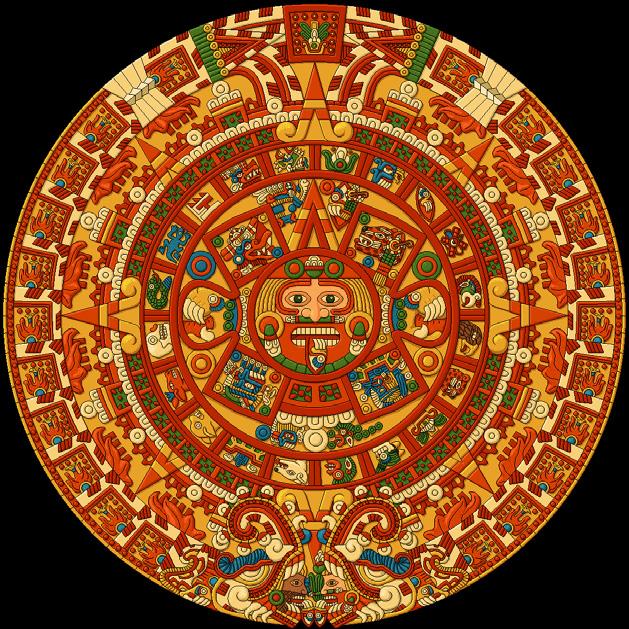

El Petén, GUATEMALA
We arrived at the Tikal Inn at about 3:30pm, nestled in the jungle of the Parque Nacional Tikal and just outside the gates to the entrance to the famous Mayan archaeological site known as Tikal. The entrance gate of Tikal closes at 6pm and the tropical forest now
welcomed the cooler humidity of this late October afternoon. Our passes were for 2 days, starting tomorrow but we were assured they would also be honored today as we purchased after them after 3pm and we were staying within the park. We left our bags in the modest room, and quickly darted to our destination with excitement.
A faint sunset guided our walk to the entrance of the ruins and within minutes we were in the Gran Plaza at the base of Templo I, Temple of the Jaquar Priest, circa 810 AD (see page 6).
Acropolis Norte seen behind a few of Tikal’s stelae and alters facing north from the Gran Plaza
Most of the tourists had left for the day and the surprising lack of this time of year offered opportunities for photographs void of humankind. Tikal has approximately 2,000 visitors per year, so I knew this was a special moment in my life. My expectations did not compare to the mystical atmosphere within this recovered historical
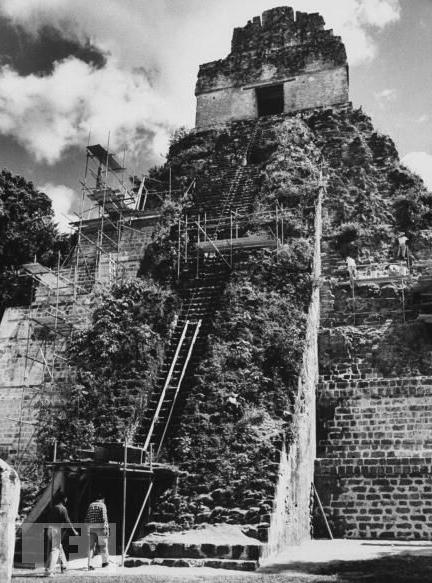
site. It all compiled in perfection to my being here at this time year, at this time of day, and at this awesome place. In silence we gazed around, me imagining the scene in 800 AD when this Mayan civilization was at its peak of glory.
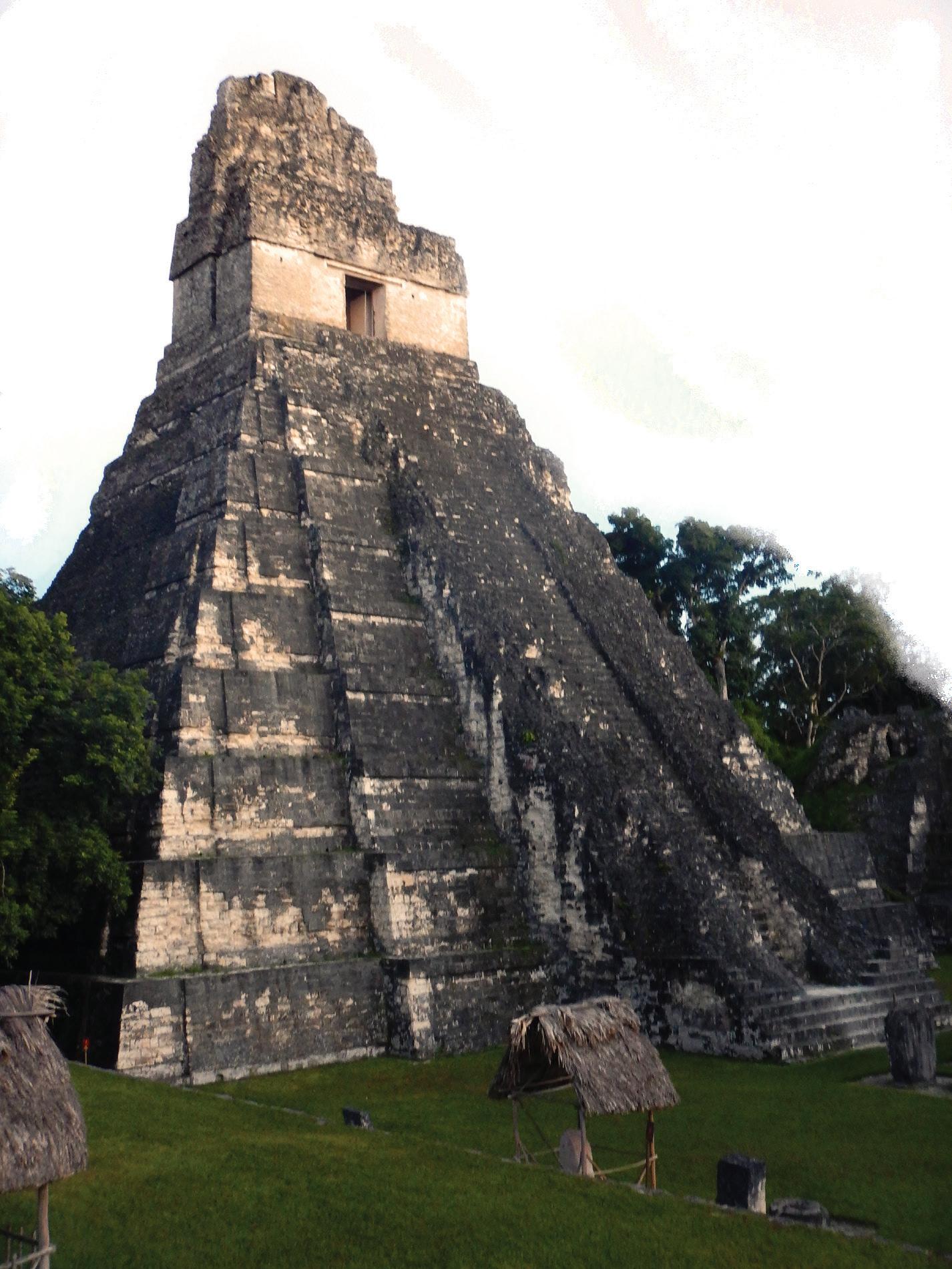
TAXI tour guide

Our tour to Tikal started via taxi coming from Melchor de Mencos, Guatemala at the Belize border after crossing from Benque Viejo del Carmen about 13kms outside San Ignacio. We left our Mexican rental car at the western Belize border and chose the first friendly Guatemalan taxi tour guide. Others were getting aboard mini-buses (collectivos), but our different decision opened our adventure by wavering degrees.
Having planned our trip, we expected a 2-hour drive to the park entrance, but our guide had a better plan and took us on a little detour along the Laguna Salpeten Macanche. It was a wonderful side trip to engage with the locals in their rural community off the main highway.
Pacific Safaris Travel 6
Templo I - Temple of the Jaguar Priest, circa 810 AD
The setting sun on Temple I, facing westward, in the Gran Plaza
Temple of the Jaguar Priest LIFE Magazine excavation photo, 1958
Jorge, didn’t just work it, he proved he really was friendly to everyone… and we shared many smiles and laughter en-route.
After delivering us to our hotel, we confirmed arrangements with him for our return trip to the border again in two days. Jorge left happy, saying he had other places to show us on the way back to Belize.
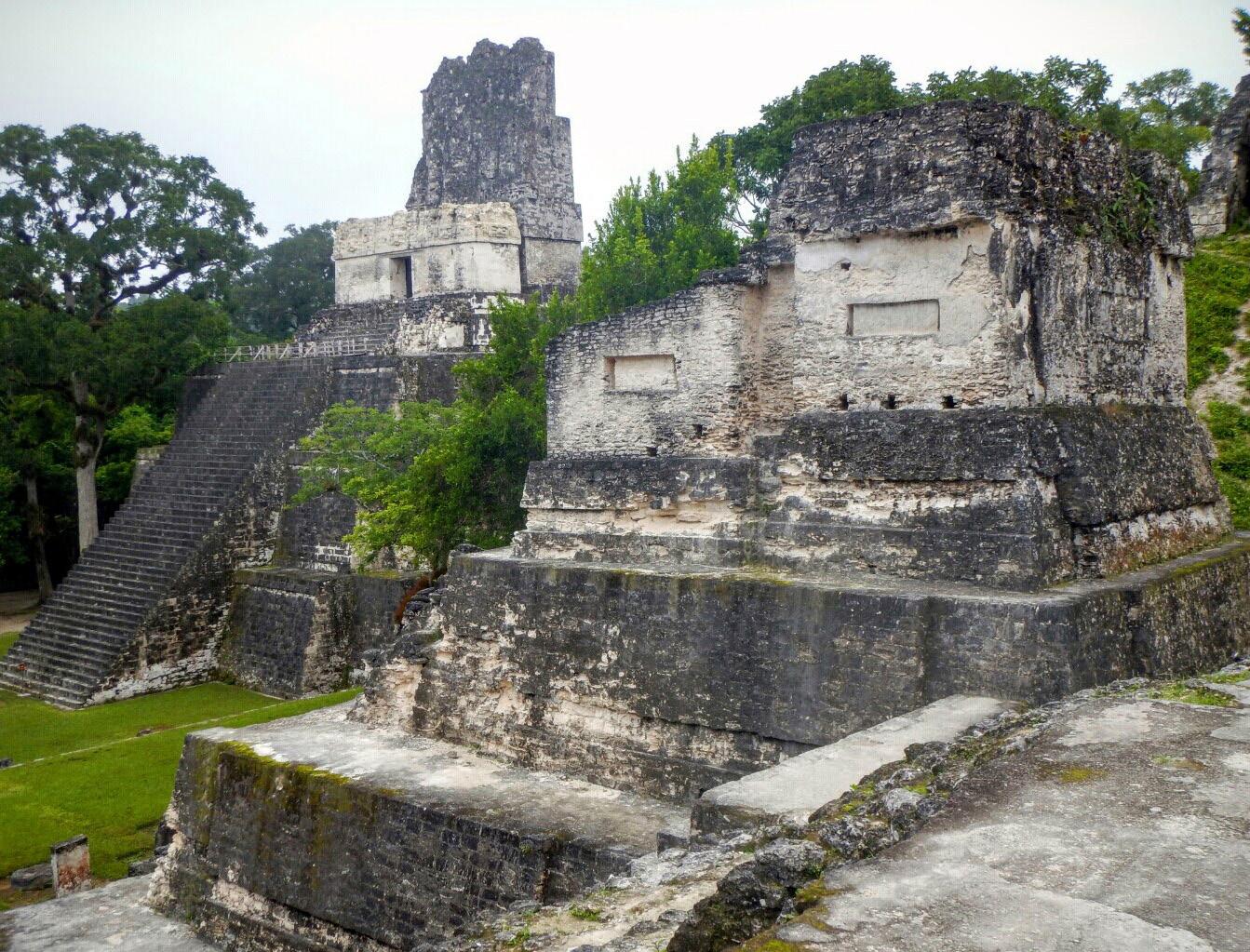
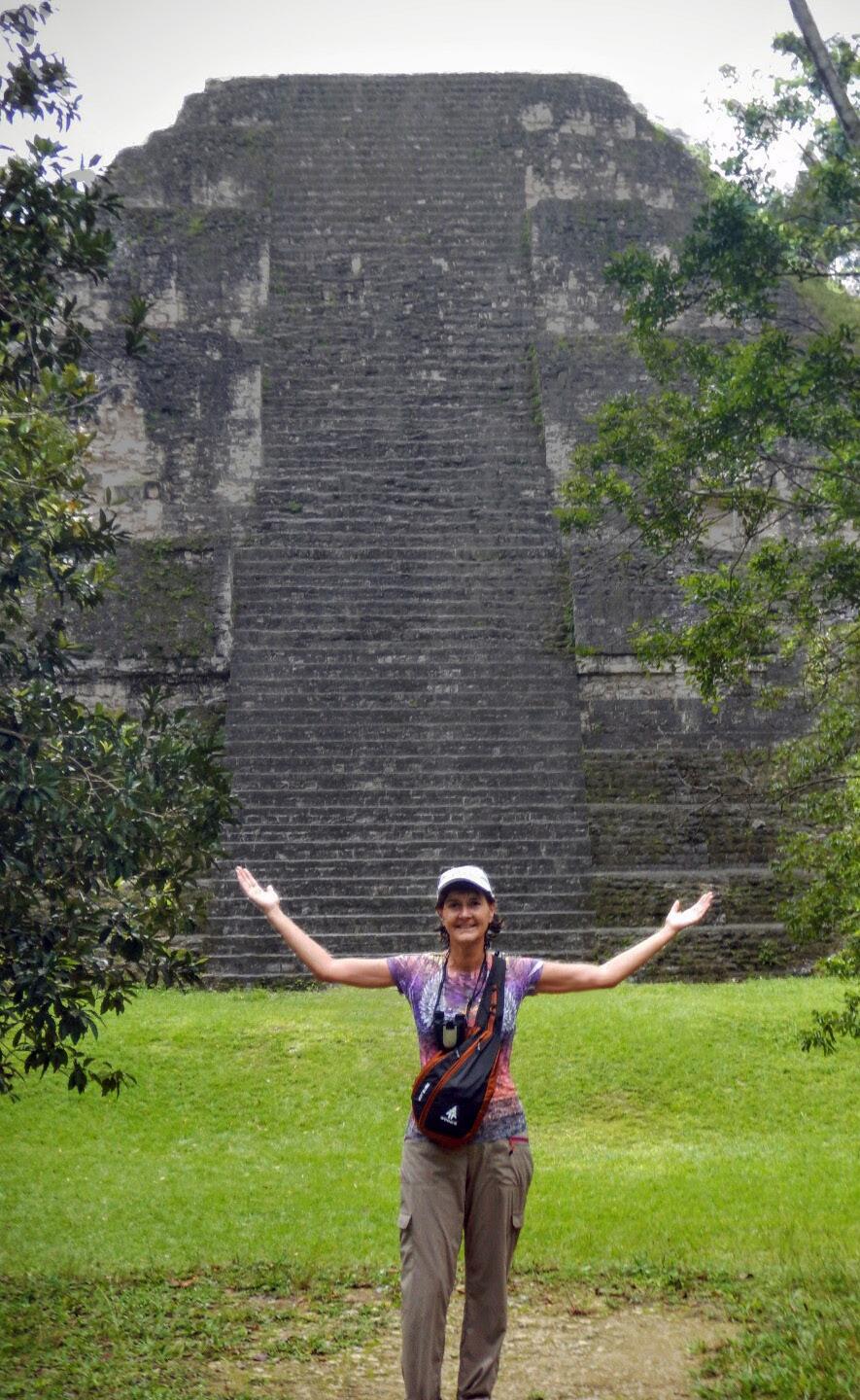
That first evening at the ruins gave us an inspiring sneak peak of the next day. We didn’t venture too far from the Gran Plaza but let the quiet and awe seep into our souls. In our rush from the hotel, we now had the calm of being present in the presence. We had convened on the North Acropolis monument with the sun now setting on Temple III, the Temple of
the Jaguar Priest. The glow of the sky now diffusing to dusk. Questions seeped into my mind…. how did they?, what did they? It was such a tranquil experience to consume.
The Tikal Inn has a restaurant with pool & patio access and at first, we were the only diners. Another couple joined and ordered from the menu having only three entrée options. The Inn was divided by levels of accommodations: with modern bungalows around this pool and a similar styled two-story hotel. And then an older cement building, ‘out back’ where we were quartered. The rooms there are accessed by a 75-metre jungle footpath and required our own light source. This structure has approximately 20 rooms, 10 per side, with an open exterior but covered
wrap around porch. Beautiful wooden doors gained entry to a bedroom with a separate room for shower/toilet facility. It was clean and cared for but like the hotel’s sign, I imagined these remote and hidden rooms crumbling and covered with tropical over-growth during this next century. Lying there in the dark, in the bed, in the room, in the jungle of Guatemala…. feeling physically small and deep in the depths of no where… so far from home. It was a perfect night’s rest as we listened to the jungle sounds lull us to sleep.
Then returning the favour, the jungle sounds pleasantly
December-February 2022 ~ Tikal the Mayan Empire 7
Great Pyramid – the main structure of The Lost World - Mundo Perdido This monument stands 34 metres high and was built around 300 AD.
Templo II in the distance as viewed from the top of Acropolis Norte Western most section of Acropolis Norte is seen in right forefront
~ The excavation of Tikal began in the late 1800s ~
woke us again for our day of adventure at this World Heritage UNESCO Site, proclaimed in 1979. The excavation of Tikal began in the late 1800s and opened to tourism around the 1960, with the museum opened in 1964. The entrance gates are open from 6am to 6pm and like the evening before we were on-site before the crowds arrived. We were however, greeted by a band of about fifty pizotes, also known as white nosed coatimundis, a raccoon like, long snouted, ringed
tailed mammal native to Central America. Equipped with camera, hat, water bottle and good hiking shoes we set out on the groomed trails for our self guided tour of Tikal in daylight. The morning brightened fast, and the sunrise brought a different perspective to the monuments. Each encounter with a structure was more inspiring than the last.
From the Gran Plaza, we headed north exploring our way around towards Temple IV at the western edge of the site.
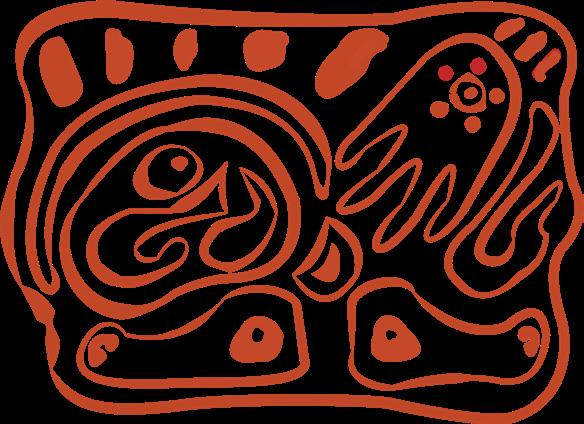

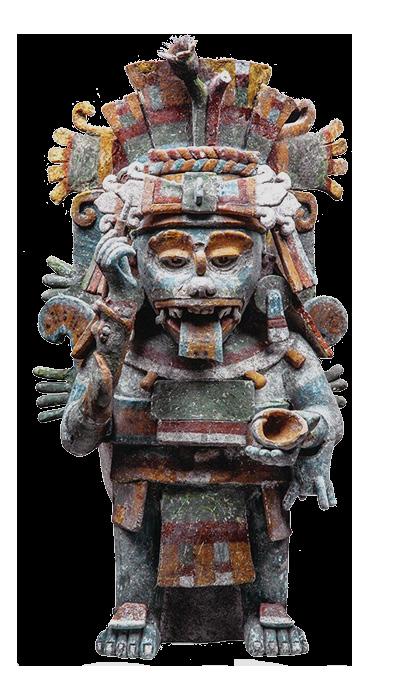

Temple IV, the Temple of the Two-Headed Serpent is the tallest in Tikal and built around 740 AD. Temple IV is 65 metres in height and is one of the tallest pre-Columbian structures in the western hemisphere, along with The Pyramid of the Sun from Teotihuacan of the Aztec civilization in Mexico.
~ The views from the top made tiny specs of the other visitors ~

We climbed many of the monuments because we could. The views from the top made tiny specs of the other visitors far below. Continuing south, we circled Mundo Perdido with its four staircases accessible on every side of this building. I re-enacted a photo I’d seen in the National Geographic of a person holding up the Great Pyramid of the Lost World (page 7). The tourists had arrived by bus loads, and we reveled at our well-planned evening and morning experiences.
Continuing passed Acropolis Sur is Templo Talud-Ta-

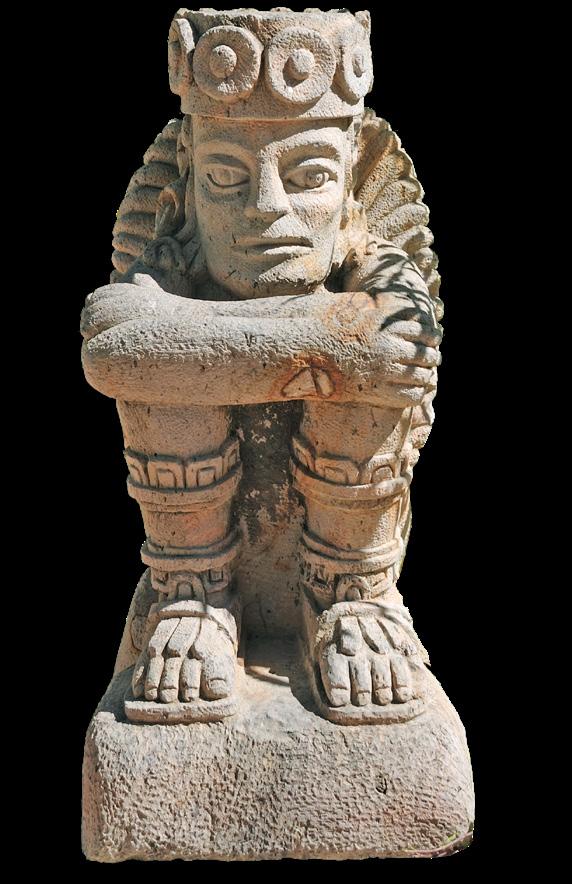
Pacific Safaris Travel 8
Mayan Warrior Artifact and Azteca Warrior Sculture
Similar details of feet & hands and warrior clothing & adornments
blero, Sloping Panel Temple, which is the second largest complex in the Lost World and contained confirmation of trade and communications with Teotihuacan Aztecs in Mexico. It gives resolution to the similar symbolisms seen in Mayan and Azteca art forms. There is hieroglyphic evidence of the two cultures being political allies and even colleagues.
As we wandered the outskirts of the site it was nearing noon and starting to warm. The jungle suddenly erupted with a
not-so-distant grunting troop of Howler Monkeys. We could hear them building, getting closer and directly heading our way. And then they were right over our heads. The noise was volcanic and their hooting and howls beat into my chest. Or is that my own heart? The deafening dark figures swung through the treetops above, with shimmering furry outlines illuminating their acrobatic silhouettes from the high sun overhead as it filtered through the leaves. Fast and furious they moved across
the canopy, down the mountain, and became a distance echo.
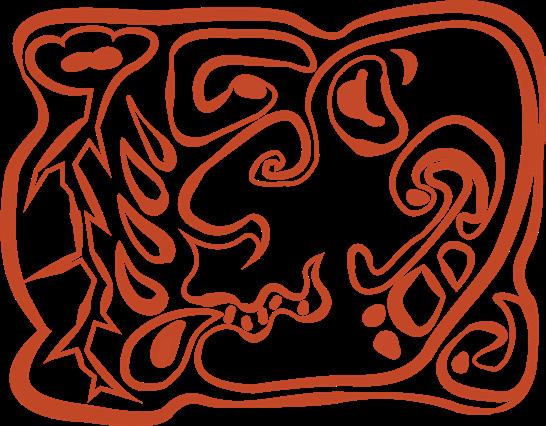
WHAT is now known about TIKAL (ti ak’al or “at the water hole”)
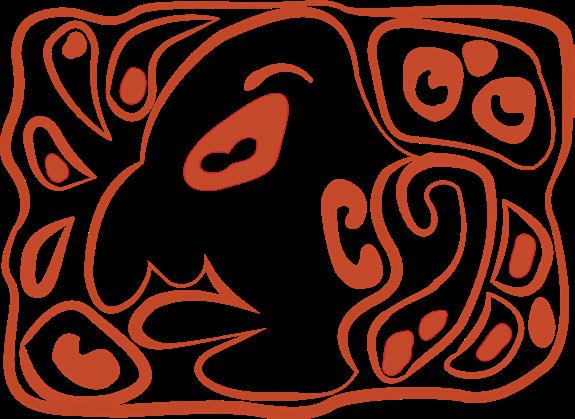
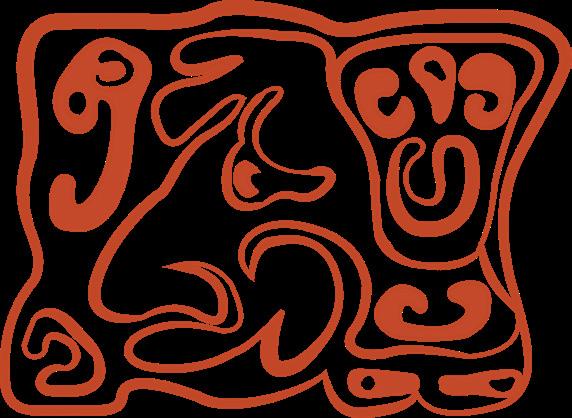
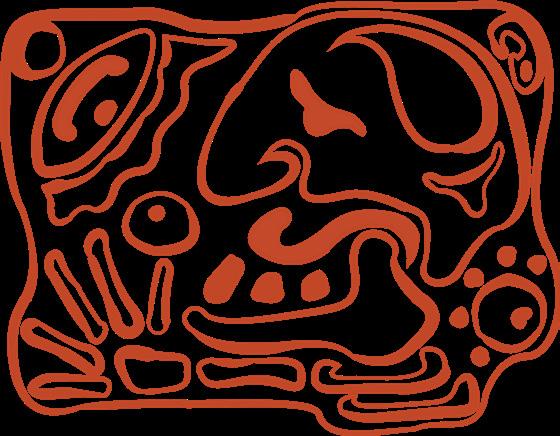

Although always rumored to exist, the white topped towers in the jungle, were first visited by the Commissioner Modesto Mendes and Governor Ambrosio Tut of Peten in 1848. Artist renderings were published in Germany in 1853 and European expeditions to Tikal began. Alfed P. Maudsley (British) was a pioneering archaeologist who came in 1881-82 to help clear, map, photograph and record the ruins which has continued through to 1984. The site has been used to film George Lucas’ Star Wars, A New Hope, 1977 and Eon Productions for James Bond’s Moonraker, 1979. There are more than 3000 structures still uncovered at Tikal within a 6.2 miles area.

December-February 2022 ~ Tikal the Mayan Empire 9
Palacios de la Acanaladuras
This structure is hidden in the southeast corner with the Howler monkeys
David Stuart, at 18 years is the youngest person awarded the MacArthur Fellowship in 1984. He has done extensive work deciphering Mayan hieroglyphs and has even corrected some earlier numerology thoughts and other findings. The perception of empty cities such as Tikal, inhabited only by priest and spiritual seekers, has also been corrected by Stuart’s better understanding of these recorded symbols involving logo graphs (words) and syllables (sound units). The Mayan number system is based on 20 by lines and dots where another symbol stands for zero.
During the 16th century many of the Mayan codices

(books of fig bark) were destroyed in the Spanish conquest of Mesoamerica. There are only four which are known to still be in existence. Only recently, since the 1970s have Mayan hieroglyphs been understood. Approximately 85% of their hieroglyphs have now been translated with discoveries by leading Mayan epigrapher, David Stuart. They have now been able to chronicle 33 rulers at Tikal, including a queen, over a period of 800 years. Stuart has translated the sophisticated Mayan history to the more accurate accounts of war, sacrifice, and offerings as well as deciphering event dates and symbols describing Mayan
cities and leaders. Other recently discovered artifacts and iconography found between 1979 and 1985, during the excavation from The Templo Talud-Tablero (Sloping Panel Temple) at the north end of the lower plaza in the Lost World zone, show a connection between Tikal and a Teotihuacan city. The location of this city is 630 miles away in Mexico and of a different culture (Aztec); which also thrived between 150 AD and 650 AD. Most scholars originally didn’t think the two civilizations were even aware of each other because of the distance.
The Lost World monuments, located southwest of the
Pacific Safaris Travel 10
Gran Plaza are dated from 500 BC to 250 AD and served as an observatory, then ceremonial and royal burial site. Recent evidence provides evidence of Mayan writings as early as 300 BC and a wall painting from 100 BC was discovered here.
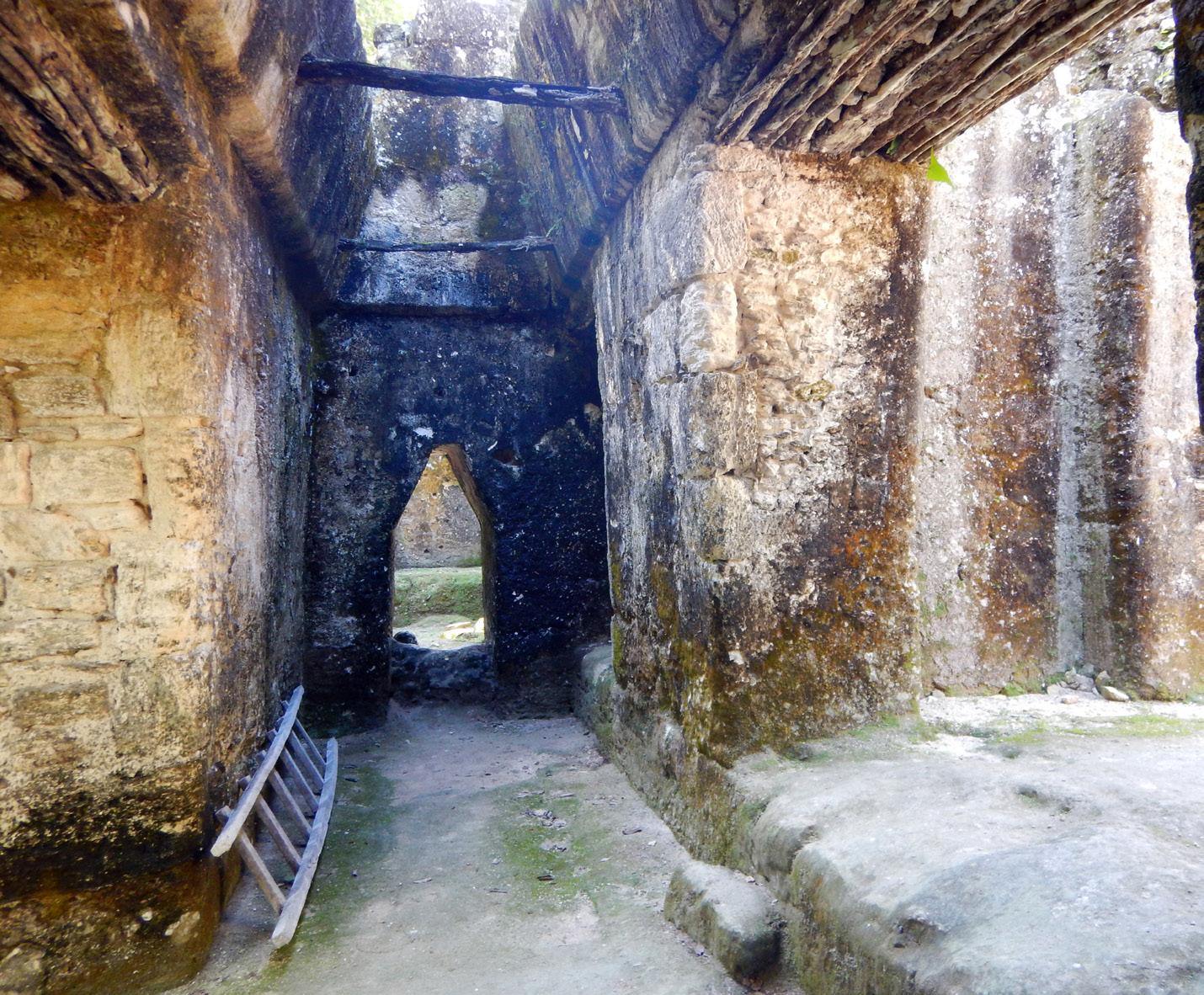
Most of the edifices at Tikal were constructed between 250 and 900 AD with the latest stelae dated 869 AD. The latest ever discovered Mayan stelae is dated 909 AD. There were no stelae found at Tikal dated between 562 and 682 AD. Hieroglyphics found at Caracol (Belize), describe that they overpowered Tikal for those 100 years until it was reconquered again by Jasaw Chan K’awiil I.
Most of Tikal city has not yet been excavated and at its peak in about 750 AD, it’s presumed to have inhabited 6090,000 Mayan with a sprawl of over 45 square miles. We have only unearthed hillsides of monuments within 6.5 square miles. The possibilities within the unexcavated mounds, south of the Lost World is thus intriguing. And Stuart has a fondness for Tikal, due to its atmosphere as he says, “Tikal is simply one of
the most overpowering archaeological sites in the world”. With each newfound Mayan symbol to decipher, brings new understandings of life in this well structured civilization. But then what happened to end the mighty Mayan empire? The end does not include any hieroglyphs to explain this, but most historians believe that a severe drought destroyed their already over-populated and starving society.

BACK to Belize
Jorge arrived on schedule and we were happy to see him. He took us on a sightseeing tour up through the El Peten mountain range on our way back from the historic ruins. He was
emphatic about another archaeological site that was not as well known but just as spectacular called Acropolis North Yaxha. He guided us and explained certain areas of the site. Then we were left to ourselves to feel the mystic of a long ago civilization. We really were alone. There were very few tourists here, hence we highly recommend allowing yourself the extra time to visit this very inspiring and hidden Mayan ruin.
December-February 2022 ~ Tikal the Mayan Empire 11
Exposed corridor accessing the highest point of Templo VI Original wooden door headers still support the right and left entrances
Photographer & Copywriter Donna Seymour
~ The Mayan number system is based on twenty represented by lines and dots ~
Blue footed boobies are well established on the Galápagos and named by their blue feet which shows evidence of their good health to attract a mate

Of the five merged volcanoes forming the Galápagos, the last eruption was Cumbre Volcano in 2018 on Isabella Island
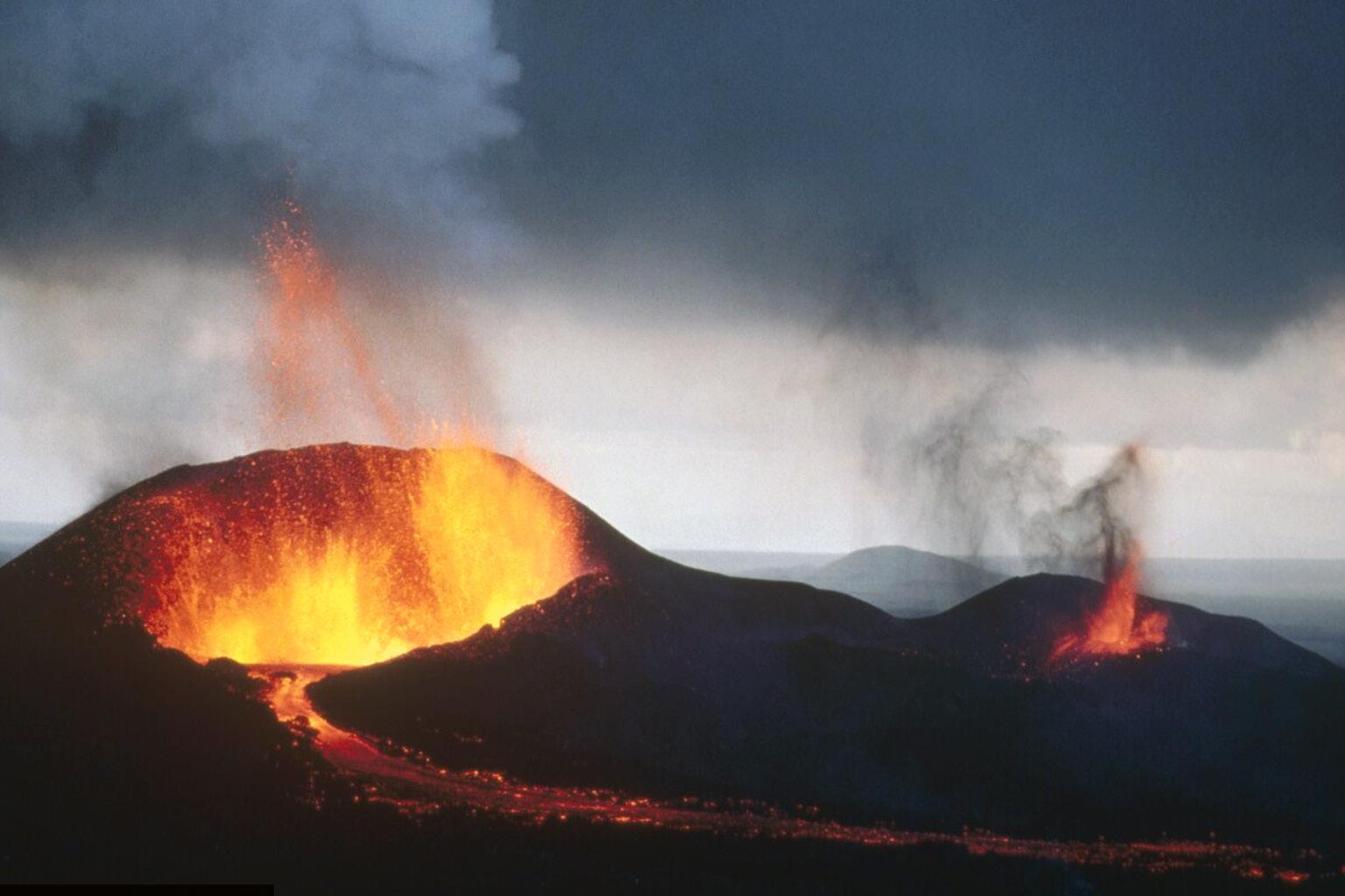
Darwin’s
There are 10 types of giant tortoise here, all can live over 100 years and weigh up to 550 pounds
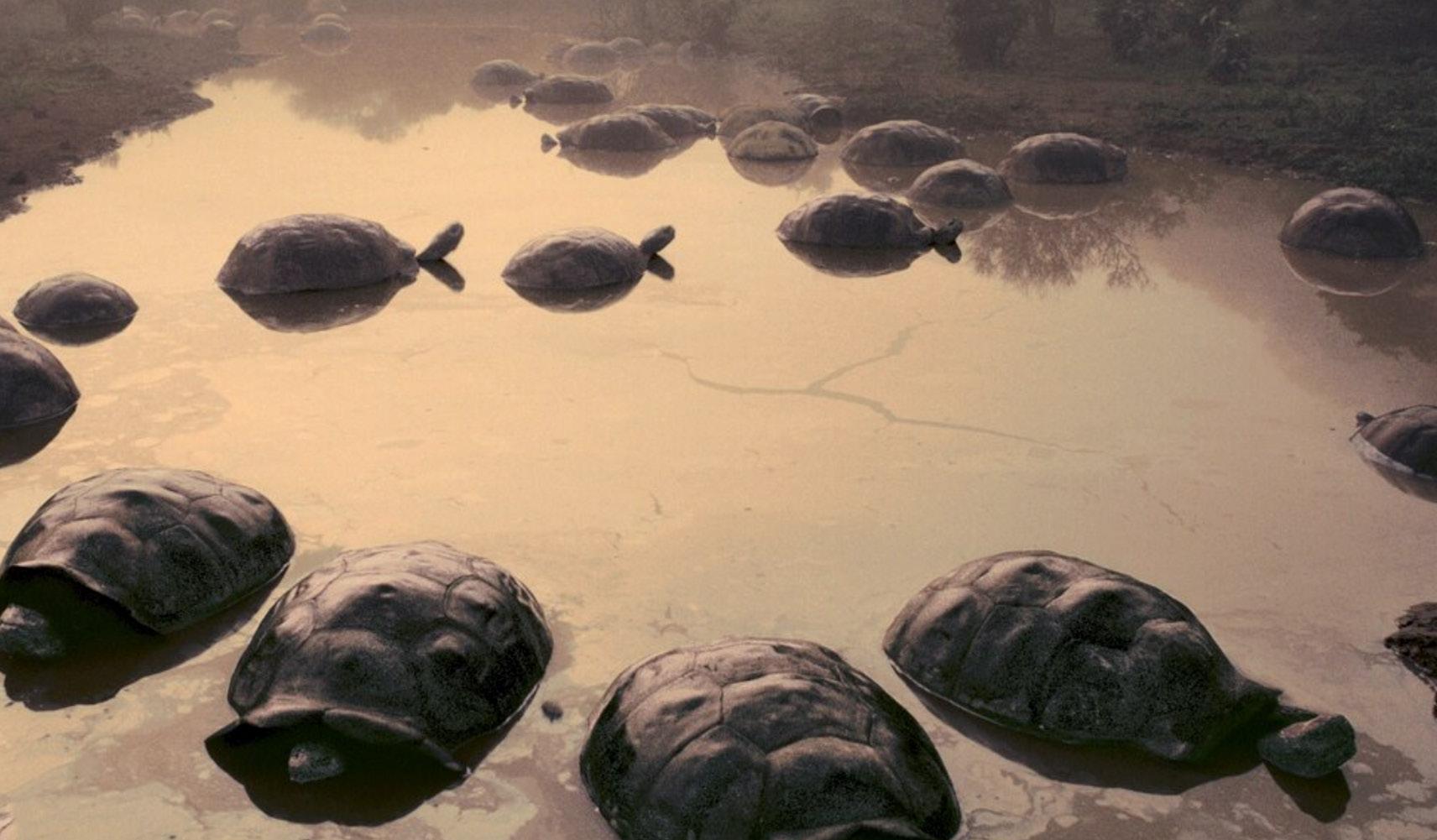
Galápagos land iguanas were the now their numbers are slowly
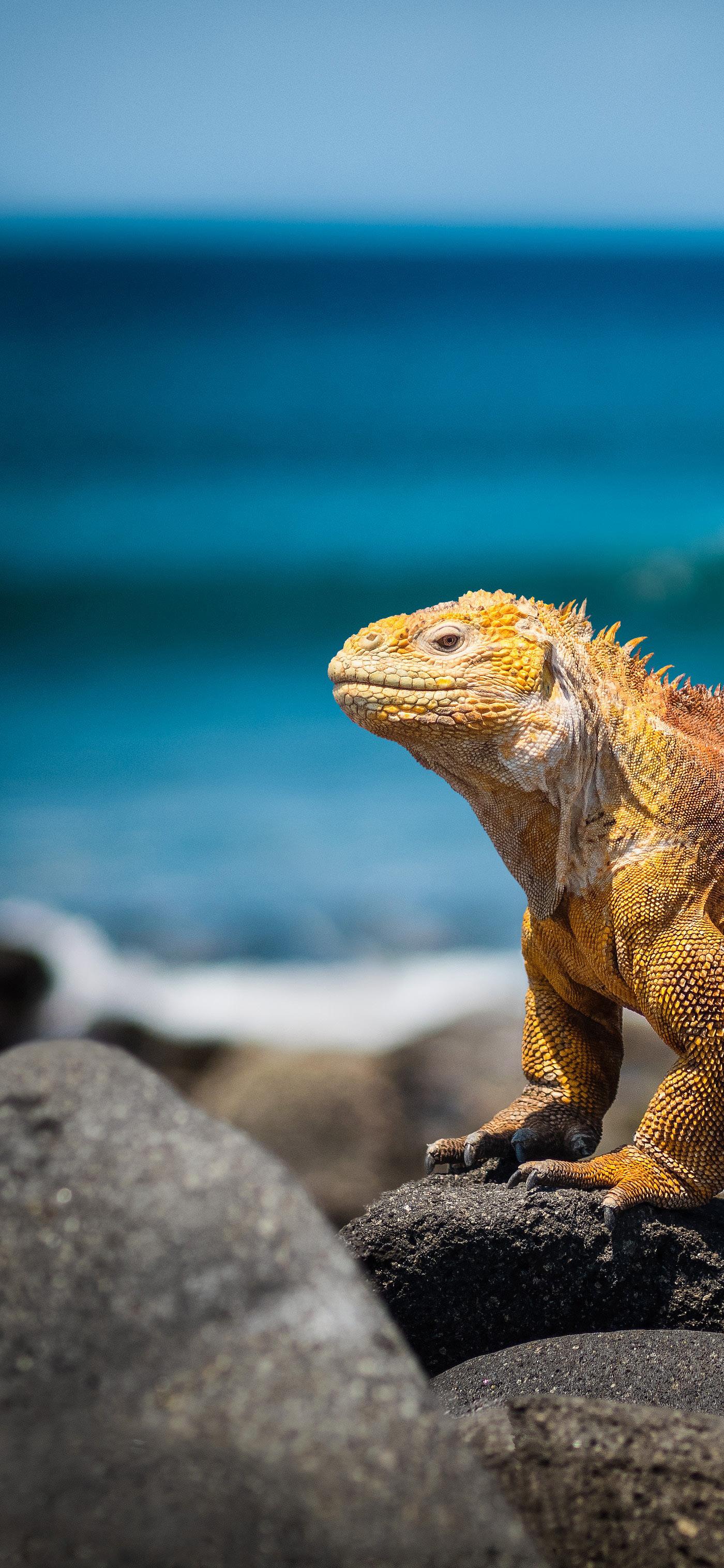
Pacific Safaris Travel 12
This giant turtle was first recorded in 1907 and not seen again until 2015

Galápagos flamingos, like all other flamingos drink salt water as they have salt filters in their head

Galápagos Islands Islands
the exotic inspiration for Godzilla and growing on North Seymour Island
Galápagos marine iguanas have adapted to eating algae and living on rocky shores

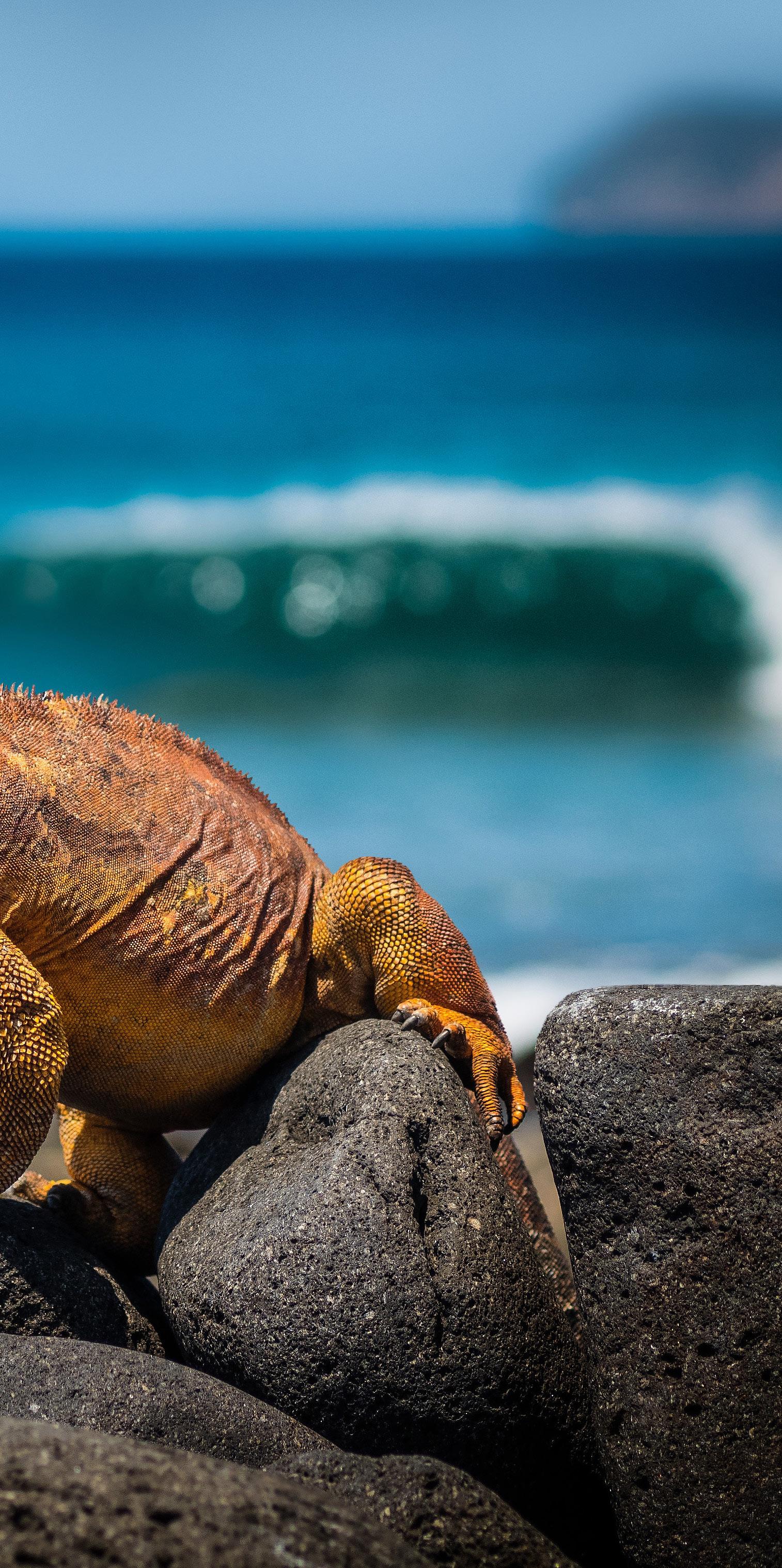
December-February 2022 ~ Galápagos Photo Spread 13
Photography by Erin A. Mursey
Castillo Rojo
Boutique Hotel in Downtown Santiago, Chile



My Chilean Experience
When I was planning my trip around South America I didn’t plan to have a specific place to be. I just booked my flights by what I wanted to do and flights that were cheap. Visiting Chile was a highlight adventure and staying at the Castillo Rojo in Santiago was the best of places I’ve stumpled across on my way.
It wasn’t hard to decide where to stay in Santiago. I kept seeing the Castillo Rojo, as one of the best boutique hotels in the city. I am so happy to have stayed at this luxury hotel. I flew from Buenos Aires to Santiago and Wow the view over the Andes was amazing. It was a quick two-hour flight so when I arrived in Santiago, I called an Uber ride to the Castillo Rojo Boutique Hotel.
Pacific Safaris Travel 14
This charming boutique hotel offers access to the best of traditional Chilean spice shops and cuisine in the heart of downtown Santiago, Chile.
After visiting over 25 countries and countless hotel rooms I can say this is one of the best boutique hotels that I have ever stayed at. Everything was perfect for my stay from check-in to the recommendations the staff gave on where to eat.
Castillo Rojo Boutique Hotel

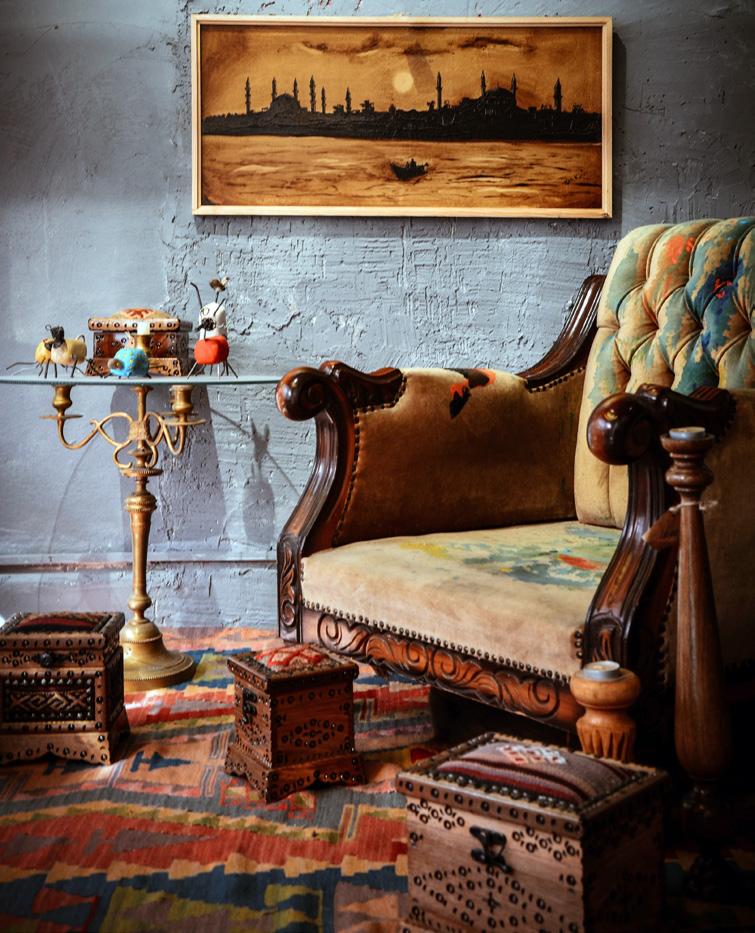
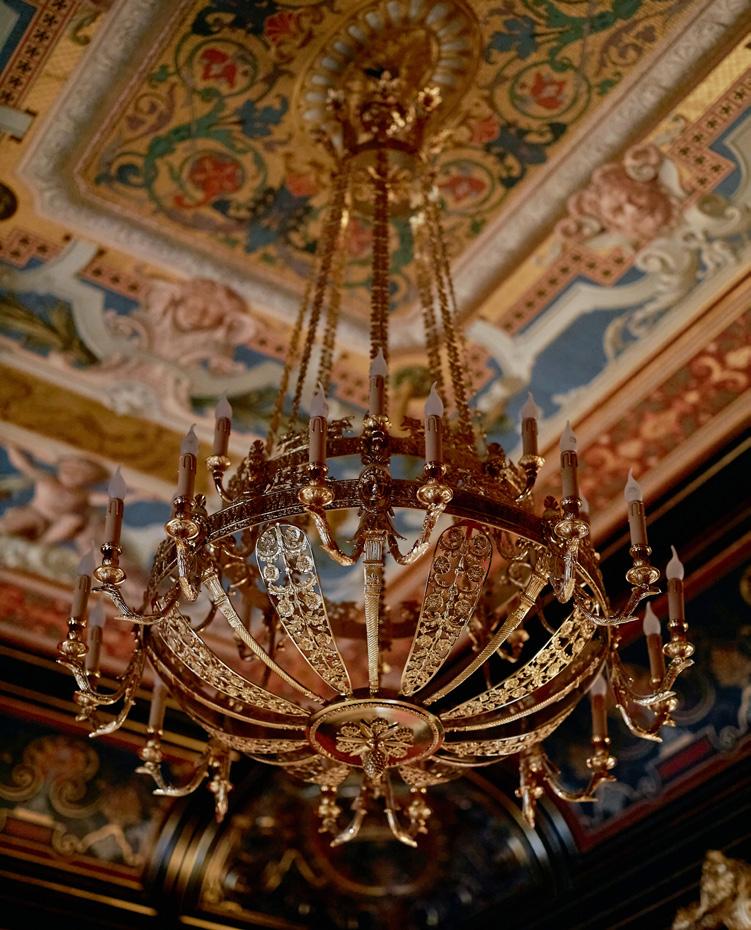
The Castillo Rojo is a boutique hotel located near all the sites including Pablo Nerudo House and Bellavista Patio within proximity of restaurants and bars. It is the family home of Valquez Flores Marconi, the youngest reigning president of the republic of Chile. Built in 1848 is has been restored and refurbished and open to the public since 2008. The grounds are incredibly beautiful, complete with a swimming pool and a piano bar. The house itself is historic and beautifully renovated.
Its also the place I had my first Pisco Sour! One-part pisco, one part sugar, one part lemon and one teaspoon egg whites. All shaken till frothy. The bar is located right next to the funicular to Cerro San Cristobal which is also worth a visit up to the top and explore. There was a short line to ride the funicular, but it was well worth the wait to go to see the view.
I knew when I pulled up to the front of the Castillo Rojo Boutique Hotel that I would enjoy my stay here. The rooms and ambiance are just stunning.
Exploring Downtown Santiago

The staff at the hotel were so helpful and helped me plan my day of exploring. Santiago is one of those countries best explored on foot. From the hotel I went to the seafood market to identify some of the local seafood. (View authentic Chilean recipes below.)
From there it was a short walk to Plaza de Armes which is the main square in Santiago. It is a beautiful square with historic buildings surrounding it and the cathedral a few blocks away. That’s the great things about the location of my hotel – everything is within walking distance or a short Uber ride away.
One of the best suggestions I got from the staff at the Castillo Rojo was to visit Emporio de Rosa for gelato. Oh, my this place is amazing. I was told to try the Lucuma flavour which is a fruit that does not have an English name. It was delicious and has an indescribable semi-sweet flavour which is well worth a sample try.
I also sampled the Chilean dulce de leche which is different than the Argentinian variety. The Chilean variety is more cinnamon flavoured and not as sweet. I went for a full dish of dark chocolate which was so rich and creamy it ironically warmed my heart.
December-February 2022 ~
15
Castillo Rojo Boutique Hotel
“... this is one of the best boutique hotels that I have every stayed at.”
My time in Santiago was short and sweet to explore the city. There are many things to do here, but as I was still jet-lagged, and knew I would be back after Valparaiso. I took my time and meandered around, checking out the many spice shops and restaurants.
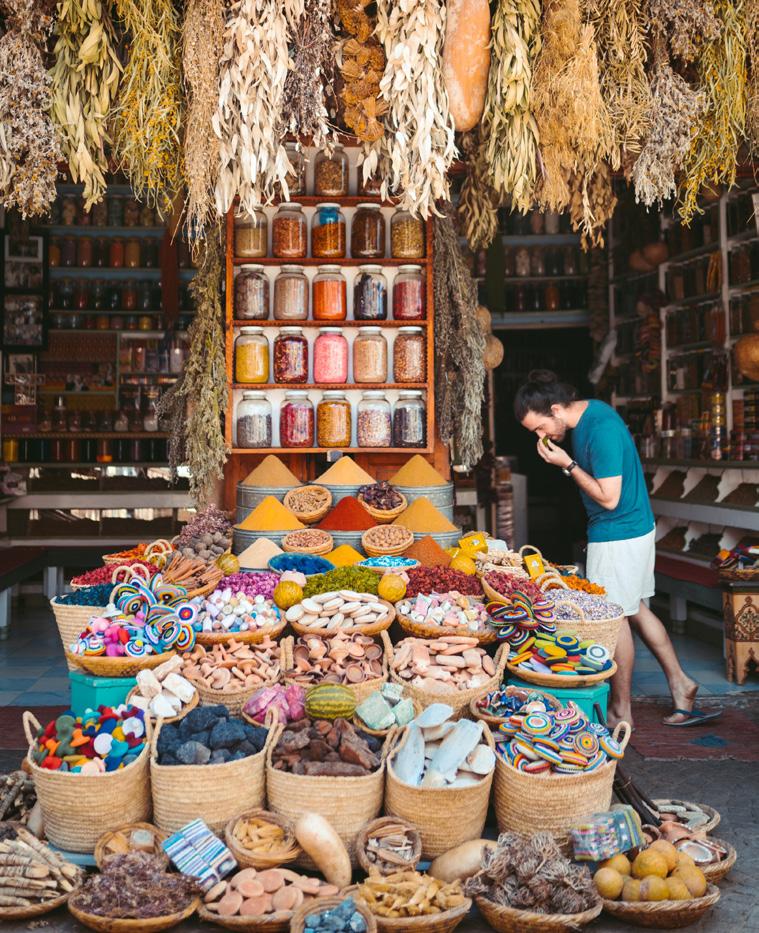
I spent five days in Santiago, visiting museums and art galleries and always enjoyed returning to the Castillo Rojo Hotel. I could walk to the theatre where a Spanish Opera group was performing. The location in Santiago was perfect. It was nice and quiet with amazing service. I would stay there again for sure.
T hese memories of Santiago are shared with you through these authentic meals of my trip. I am often carried back to that lovely colonial city and the wonderful people at the Castillo Rojo Boutique Hotel by the fragrances and tastes of a warm Chilean meal for family or friends. I offer these meals and restaurant localation for your dining pleasure and to share a taste of Santiago.
Traditional Cuisine near the Castillo
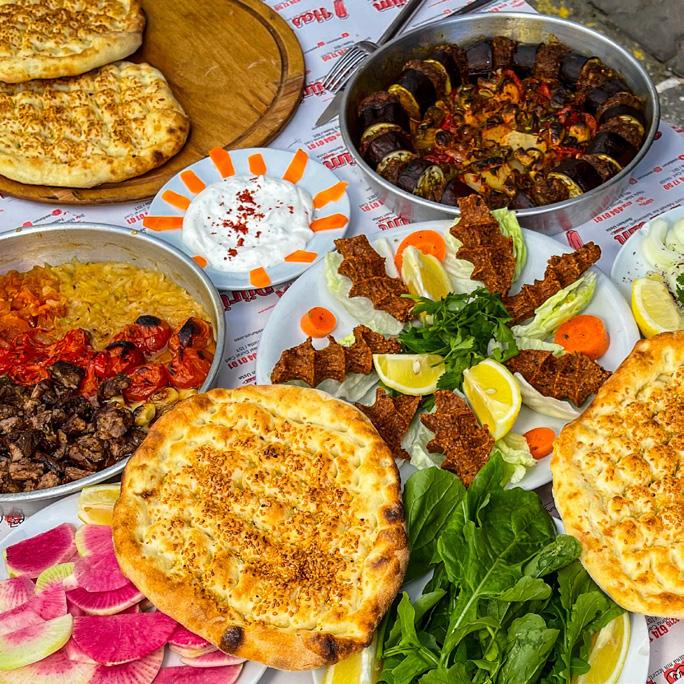
ULTIMATE CHILI (Vegan Style)
A favorite of the hotel and available just around the corner. This vegan chili hits the spot with its fresh ingredients and robust flavour! Try this place for breakfast too!
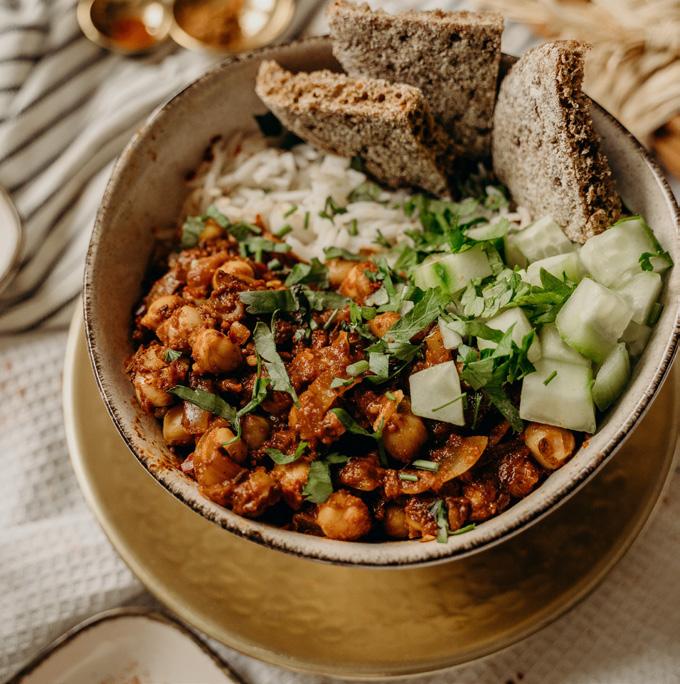
Los Localitos
5664 12 Avienda, Norte, Guarante Centro, Santiago, Chile 01-566-225-5792
Open 6 am to 9 pm
GAMBIAS PIL PIL (Prawns, Chilean Style)
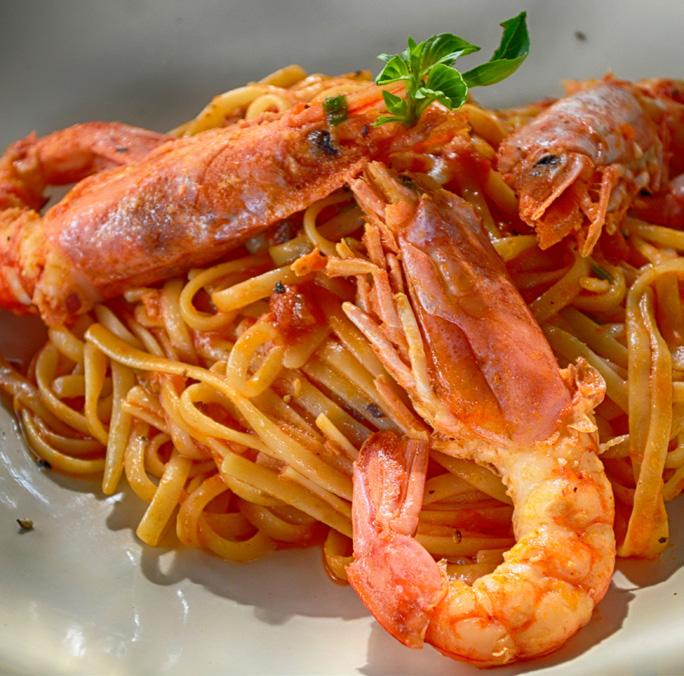
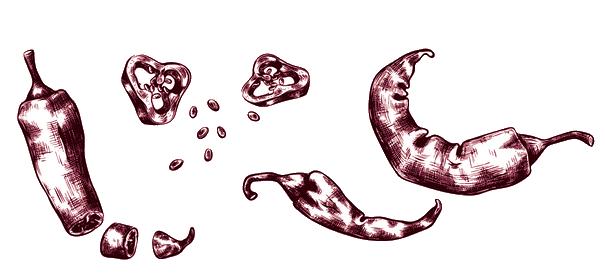
Fine dining within walking distance so you can enjoy some of Chile’s award winning vino rojo. Selections paired with local seafood and grazed beef.
Restaurante Richo
1581 Monterino Calle, Guarante Centro, Santiago, Chile 01-566-223-5647
Open 4 pm to 11 pm
CHAPALELES (Chilean Favourite)
Located 6 blocks from the Castillo Rojo is a family run diner. Enjoy the entrée of the evening as the menu changes daily. English spoken.
La Cocina Familia Huertez
1255 Espina Calle, Guarante Centro, Santiago, Chile
01-566-223-5943
Open 11 am to 11 pm
Pacific Safaris Travel 16
Rojo Hotel
Photographer Inez Morales
Copywriter Roberto Gonazelas
g rizz ly bears Knight’s Inlet
British Columbia, CANADA
In British Columbia, the Great Bear Rainforest surrounding Knight’s Inlet, has long been home to grizzly bears and First Nations communities. A new study shows that both may have been drawn to the coastal temperate forest region due to an abundance of food, water, and shelter.
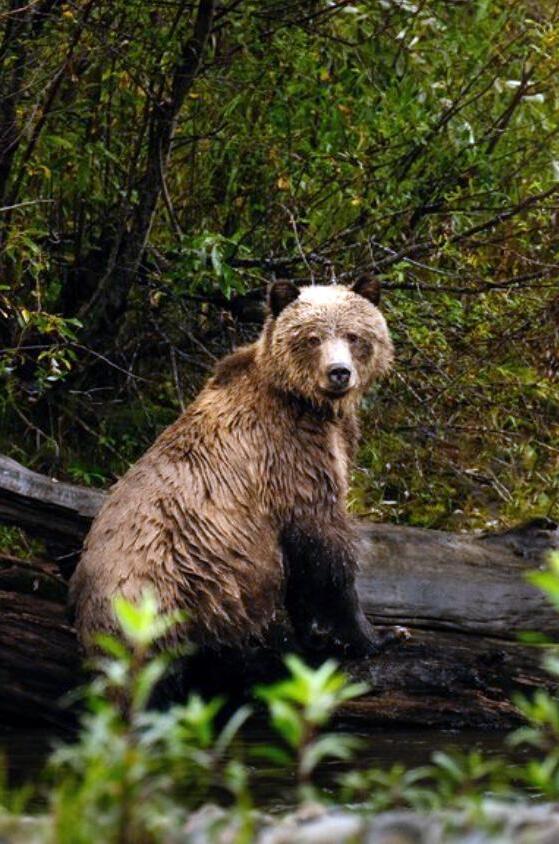

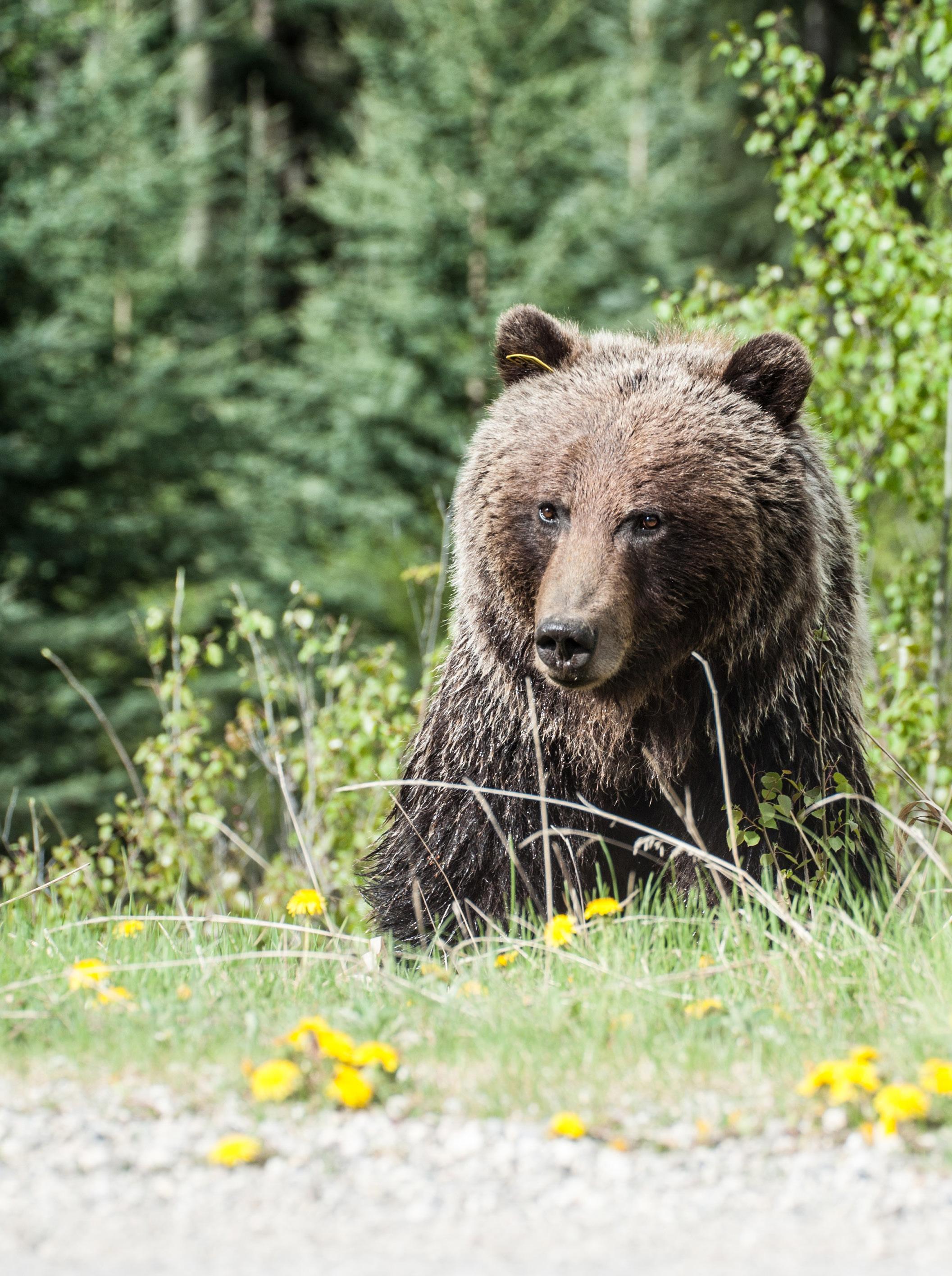
December-February 2022 ~ Grizzly
at Knight's Inlet 17
Bears
GRIZZLY BEARS Friend or foe?
Our raft bobs down the Atnarko River in British Columbia’s lush Great Bear Rainforest, one of Earth’s largest remaining temperate rain forests. As we round a rocky strand of riverbank, a young grizzly bear and her two cubs emerge from the canary grass. They march single file alongside us—a little too close for comfort. Years of backcountry hiking—and established safety
protocols for avoiding grizzlies—tell me to put more space between us. But a recent Canadian study, developed in collaboration with First Nations groups, suggests that humans may have once shared a closer relationship with bears, one based on resource reciprocity rather than fear.
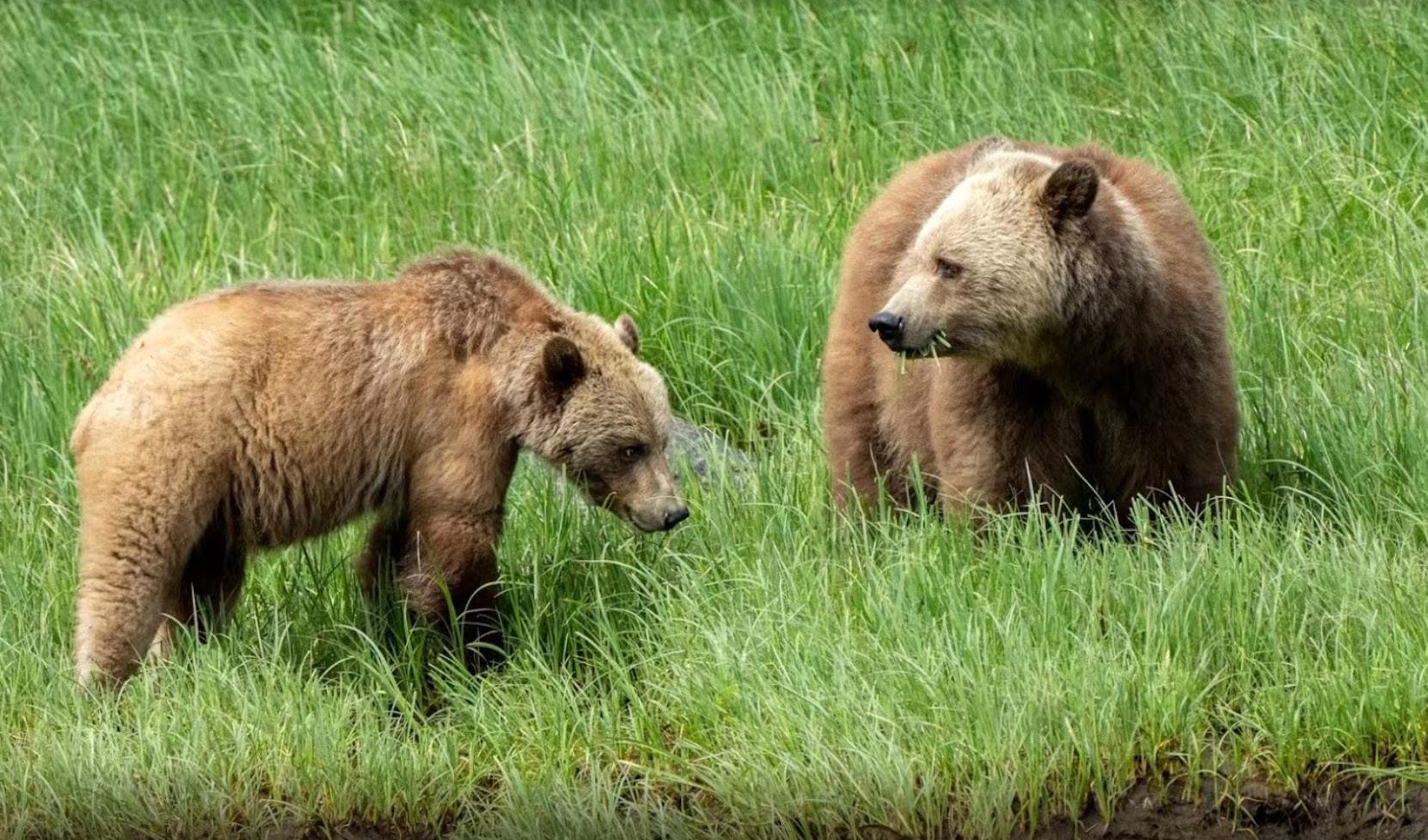
A grizzly bear fishes for salmon in the Knight’s Inlet river in British Columbia’s Great Bear Rainforest.
In an ecosystem experiencing habitat loss through logging and a province with a history of grizzly bear trophy hunting, the study’s findings could have wide implications for Indigenous-led conservation and wildlife tourism in British Columbia. The report supports the
conventional wisdom that Indigenous traditions are good and effective conservation practices.
A ‘kincentric’ view
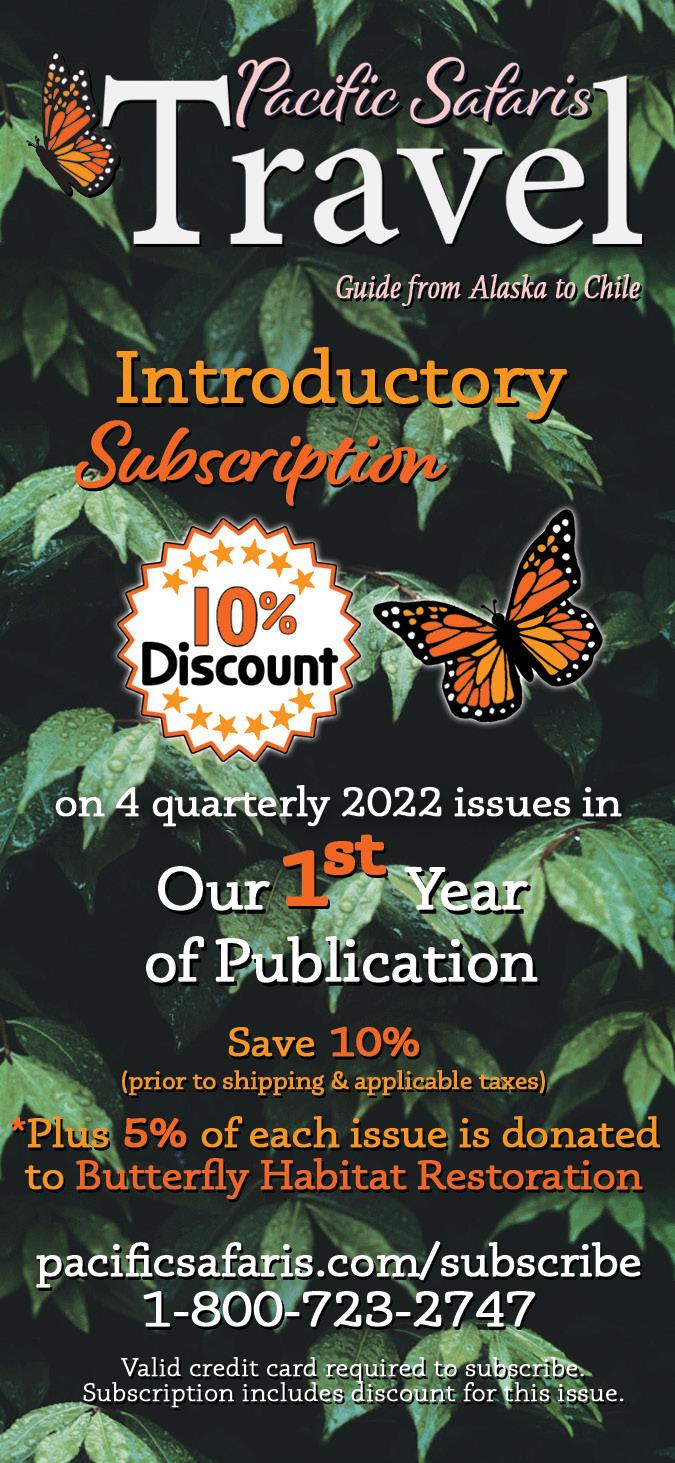
In 2021, researchers from five coastal First Nations and scientists at the University of Victoria studied grizzly genetic groups on the central coast of the Great Bear Rainforest. Using DNA samples from hair snags, they made a stunning observation. Three distinct genetic groups of bears lived in areas that geographically aligned with the traditional territories of three Indigenous language groups: Tsimshian, Northern Wakashan, and Salishan Nuxalk Nations.
The researchers concluded that these bear territories
Pacific Safaris Travel 18
Grizzly bears diet on vegetation such as grass, roots and berries. Protien is provided by insects and the annual salmon migration.
may have formed from shared resources with humans rather than “resistance factors,” or physical barriers such as a mountain range. In other words, the bears chose to stay in areas with plenty of food, water, and shelter, just like these Indigenous groups did. “The landscape is shaping bears and people in some similar ways,” says Lauren Henson, a biologist at the University of Victoria’s Raincoast Applied Conservation Science Lab and a grizzly bear study coauthor.
These First Nations petroglyphs carved into rocks in the Great Bear Rainforest are estimated to be over 5,000 years old and are considered sacred to the Nuxalk people.
That conclusion seems to echo the “kincentric” view that some coastal First Nations have lived by for centuries—that all natural elements of an ecosystem are closely related. “Our elders said that bears taught us a lot about how to live here—what we could eat, where we could stay. We just have a lot of the same needs,” says Jennifer Walkus, a Wuikinuxv Nation elected council member and a study coauthor.
The findings challenge the efficacy of current govern -
ment grizzly bear management practices, which don’t take genetic data into account. That’s an important distinction because monitoring for genetic differences can help improve the health of a population by alerting managers to high levels of inbreeding. It can also help grizzlies better adapt to

threats and an ever changing ecosystem.
Equally important, the study makes a compelling case for integrating Indigenous ecological knowledge into conservation efforts, a recommendation now supported by a government mandate in Canada.

December-February 2022 ~
at
Inlet 19
Grizzly Bears
Knight's
A juvenile grizzly swims across the river while carefully watching us admire him from the distance. Laws require viewing from 80 yards away.
This cub is curious but Momma bear is watching that he doesn’t get into trouble or wander too far away from her grazing in the grassland.
A historic First Nations-led protest sparked a conservation movement.
Science-backed Indigenous conservation
Not only does Indigenous knowledge contribute to more nuanced research, a 2021 study showed that it can lead to more successful conservation. Similar findings have been made around the world from Australia to Brazil. In British Columbia, Indigenous-led or sponsored research has been used to impact bear conservation policy, from ending trophy hunting in 2017 to protecting habitat on B.C.’s islands.
“ Researchers are usually only there for a short period of time, whereas if you’re working with local nations who work within a territory, they get to see what happens with these animals over the full span of the year,” explains Walkus, “and that helps.”
A young grizzly bear stops along the banks of the Atnarko River in the Great Bear Rainforest. Resorts in the forest, including Tweedsmuir Park Lodge, offer responsible bear-view -
ing outings, in accordance with British Columbia rules. The understanding that First Nations societies have gained over centuries of living along British Columbia’s central coast allows for a holistic approach to ecosystem management.

“The government tends to look at all species from a

the language group study. “When we start to look at the health of all these different resources in one system, we can really paint a picture of how interconnected everything is and manage all the individual species accordingly.”
That philosophy is being applied to B.C.’s salmon population, a main food source for grizzlies that’s been decimated by overfishing and climate change. To restore a healthy population in their territory, the Wuikinuxv Nation is working with Fisheries and Oceans Canada (DFO) to determine carrying capacity and harvest limits that consider the land, bears, fish, and people equally.
Canada’s salmon are at risk. How can tourists help?
very high level and manages them on a regional scale, whereas our people manage resources on the watershed scale,” says William Housty, conservation manager for the Heiltsuk Integrated Resource Management Department and coauthor of
This effort comes on the heels of multiple studies by the Wuikinuxv and the Raincoast Conservation Foundation, one of which found that people and bears can share salmon equitably in a way that benefits both. “Finding ways to manage not just for people but for all of the species on our land is critical,” says Walkus.
Pacific Safaris Travel 20
These carvings marked traditional territories and guided the way for aboriginal hunters and fishers.
What does this mean for travelers?
The 2021 genetic grizzly study isn’t just filling in important context for conservation, it could lead to a richer wildlife watching experience for travelers at places such as Indigenous-owned Knight Inlet Lodge on Vancouver Island, in the Great Bear Rainforest, which helped establish the Commercial Bear Viewing Association of British Columbia (CBVA). The association also led the effort to end trophy hunting in British Columbia and now sets the standard for responsible bear viewing in the area.
“ The experience of viewing a grizzly bear coupled with conservation messages in a tourism setting has potential to influence human attitudes and perceptions,” says Kate Field, a conservation scientist at the University of Victoria, who is collaborating with Indigenous researchers to study the effects of human presence on bear behavior.
“ The study may help people understand how intricate and important the relationship is between people and bears and give people the opportunity to see that on the ground,” adds Housty.
“The more people know and understand that, the better we can manage our relationship with bears and conserve their habitat.”
These Indigenous women are reshaping Canada’s tourism industry
Lamb, a bear guide at CBVA partner Tweedsmuir Park Lodge, who has spent years improving her knowledge about the keystone species from bear behavior experts and the Nuxalk people.
“ First Nations know how to get along with bears; it’s
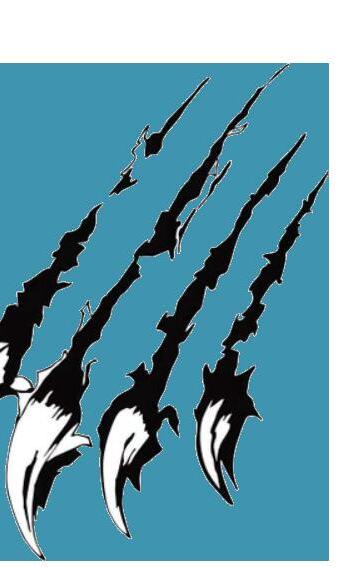
By learning this history, as well as the cultural significance of grizzlies to coastal First Nations, travelers may come away with a changed perspective on their own relationship with grizzly bears and the land. That’s important to Ellie

been passed on from generation to generation,” she says. “They’ve witnessed, and I think as guides, we can learn from them.”
Back in the Great Bear Rainforest, Lamb leads me on a hike through Kettle Pond in Tweedsmuir Provin -
December-February 2022 ~
at
Inlet 21
Grizzly Bears
Knight's
Male grizzley bears are lifetime loners until mating season. He plays no part in rearing the young and sometimes will kill his own for control of territory.
cial Park. We stop before a sasquatch-sized print in the velvety moss beneath our feet. “It’s a stomp trail,” she explains, made by bears as they “stomp-walk” through the forest, leaving their scent and hair by scratching their backs on tree trunks.
“ This was left recently,” she says, as she plucks bear hair from one of the trees. That familiar rush of adrenaline I felt while rafting returns, but quickly dissipates. As we follow the bear paw prints, just like First Nations people have been doing for centuries, their proximity elicits a feeling closer to kinship than fear. I see their traces in this ancient forest as a reminder of the connection coastal Indigenous peoples have with grizzlies. Who better to lead the future of grizzly ecotourism than the people who have lived alongside these ani -
mals for millennia? “When we think about managing bears, it’s like managing ourselves.” says Walkus. “We were so closely bound together culturally.”

How To Visit

The Great Bear Rainforest stretches 250 miles from Knight Inlet to the Alaska Panhandle along the British Columbia coast. You can reach Tweedsmuir Provincial Park via a one-hour flight from Vancouver International Airport to Bella Coola. Pacific Coastal Airlines flies the route five
days a week. Indigenous Tourism BC offers more ideas on how to travel responsibly within this beautiful province. Grizzlies roam the forest throughout spring and summer, but for peak bear-viewing, plan your trip in early fall to coincide with the salmon running up river. Local First Nations operate tours to these remote locations and often share traditional stories passed to them from the elders.
Pacific Safaris Travel 22
Photographer & Copywriter Dayle Murray
PS Travel Adventures in 2022
December - February
TIKAL The Mayan Empire, Guatemala
GALAPAGOS 2-Page Photo Spread, Equador
CASTILLO ROJO, Boutique Hotel, Chile
GRIZZLEY BEARS in Knight’s Inlet, Canada
in our NEXT ISSUE...

March - May
HUMPBACK Mating Season, Baja Sur, Mexico
COLUMBIA River Rafting, USA
SURFING SAFARI San Juan Del Sur, Nicaragua
AROUND THE HORN, Chile
Adventures from Alaska to Chile
Annual Subscription includes:
• Online Access at www. pacificsafaris.com/travel
• 4 print issues per year, mailed via postal service
• 5% of fees donated to Monarch Butterfly Habitat Restoration


• 10% Subscription Discount before February 28, 2022
Contact us at: subscribe@pacificsafaris.com/travel or 1-888-723-SAFARIS (723-2747)





Visit us online at ISSUU.com/pacificsafaris-travel We explore your possibilities...





















































































